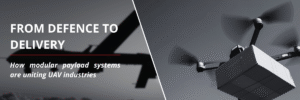Industry Pulse: How Modular Payload Systems are Uniting UAV Industries.
From Defence to Delivery: How Modular Payload Systems are Uniting UAV Industries.
Uncrewed aerial vehicles (UAVs) in the UK are no longer niche reconnaissance tools or experimental projects. They have evolved into flexible, multi-role machines whose real value lies in what they carry. Central to this shift is the rise of modular payload systems, the mechanical, electrical and software interfaces that allow a UAV to switch payloads rapidly and safely.
In this context, UK-based engineering companies such as Magnet Schultz Ltd (MSL), with specialist technologies and bespoke solutions including the newly patented QESC (Quick Electromechanical Safety Connection) are quietly playing a pivotal role. Our electromechanical systems enable the secure connection and release of payloads, forming the physical backbone of the modular infrastructure now common in both defence and commercial drone markets.
This article explores what modular payload systems are, how a UK company like MSL fits into them, how modularity is uniting defence, inspection and logistics UAV sectors, and what may lie ahead for payload innovation.
What are modular payload systems?
A modular payload system allows a UAV to accept a variety of payloads in a plug-and-play manner without redesigning the aircraft. Mechanically, this requires payloads to attach securely despite vibration, manoeuvres and weather, while remaining easy to remove or release. This depends on precision-engineered latches, locks, solenoids and electromechanical actuators, the type of components MSL has long produced for aerospace, industrial and automotive sectors and is now applying to UAV interfaces.
Electrically, payloads must connect to shared power and data buses, using standardised voltage rails and communication protocols. Software abstractions then allow the UAV to recognise and interact with different payload types without bespoke integration.
Together, these elements provide flexibility: one airframe can carry a thermal camera one day, a communications module the next, and a delivery pod after that. Modular payload systems therefore underpin UAV fleet strategies focused on utilisation, versatility and reduced lifecycle costs.
How Magnet Schultz fits into modular payload systems
Although UAV discussions often centre on airframes or sensors, the mechanical and electromechanical interface between aircraft and payload is frequently the real enabler, or constraint of modularity. This is where we contribute.
Operating in the UK, MSL provides electromagnetic solenoids, sensors and custom subassemblies that translate directly into UAV payload solutions. This includes:
- Payload release and retention mechanisms: Solenoids, latches and actuators that secure modules in flight and release them reliably.
- Fail-safe performance: Mechanisms engineered to behave predictably during power failures, communication loss or emergencies, whether remaining locked or releasing safely depending on mission needs.
- Custom engineering for specific airframes: UAVs vary widely in size, geometry, weight, centre-of-gravity limits and vibration environments. MSL develops tailored assemblies to support these constraints.
- QESC: A single-point, self-locking electromechanical connector designed for rapid attachment and detachment of payloads while supporting safety certification requirements.
We effectively provide the “plug-and-socket” between drone and payload. Though small compared with sensor suites or cargo bays, this connection point is essential. Without reliable, repeatable attachment and release, modularity becomes impractical.
How Modular Payload Systems Are Uniting the UK’s Defence, Inspection and Delivery Sectors
Across the UK, modular payload systems are becoming a shared foundation for defence, industrial inspection and emerging delivery operations. These sectors have historically operated in separate silos, yet they are now converging around the same requirement: adaptable UAV platforms that can switch missions simply by changing payloads.
In defence, this shift is already well established. The UK Government’s planned £4.5 billion investment in drones over the next decade reflects a growing emphasis on payload-agnostic airframes, rather than platform-specific designs. Military UAV programmes increasingly prioritise modular payloads for ISR (Intelligence, Surveillance, and Reconnaissance), electronic warfare and strike roles, allowing forces to reconfigure capabilities quickly without expanding fleets. Supported by initiatives such as the Defence and Security Accelerator, modularity also simplifies logistics and enables upgrades without replacing entire aircraft.
A similar pattern is driving growth in the UK’s civil and commercial UAV sector, valued at USD 1.02 billion (~£800 million) in 2024, with expectations of reaching USD 1.40 billion by 2034. Organisations responsible for inspecting powerlines, offshore wind assets, telecom towers and infrastructure rely on UAVs that can switch between thermal imaging, LiDAR and high-resolution cameras. Modular payloads allow operators to standardise airframes, reduce training burdens and scale capability efficiently.
In delivery and logistics, modularity is set to become equally important. Although large-scale operations remain early-stage, the concept of attachable cargo pods, cold-chain units and secure delivery bays is gaining traction. As CAA and EASA regulatory pathways for BVLOS (Beyond Visual Line of Sight) operations evolve, logistics providers are exploring modular UAVs as a future backbone of urban and regional delivery networks. PwC’s projection of £42 billion in potential UK economic uplift by 2030 underscores the long-term expectations for drone integration.
The unifying driver across all these sectors is the same: modular payload systems offer flexibility, efficiency and reduced lifecycle cost. Standardised mechanical and electrical interfaces mean payloads developed for defence can, with minor adaptation, be used in commercial or logistics settings. A shared supplier ecosystem, featuring companies such as ours, whose electromechanical actuators and patented devices support reliable payload attachment, further accelerates this convergence.
With global forecasts showing UAV payload markets growing steadily, and UK operators demanding more adaptable platforms, modular payload systems are becoming the connective tissue of the nation’s UAV ecosystem. Defence, industry and logistics now share the same expectation: one airframe, many missions, and the UK’s engineering base is well placed to deliver it.
What’s next for payload systems in the UK?
Several developments are set to influence the next generation of modular payload systems.
AI-enabled payload pods: As onboard processing becomes standard, payloads will incorporate AI chips and multi-sensor fusion, requiring more capable electrical interfaces and higher-density connectors.
Integrated ground infrastructure: With UK drone ports, charging stations and automated logistics hubs emerging, the same mechanical and electrical interfaces used for payload swaps may also become standard docking connections between UAVs and ground systems.
Tighter certification requirements: BVLOS operations and urban air mobility will demand payload connectors with built-in traceability, lifecycle monitoring and advanced safety performance, areas well aligned with MSL’s engineering strengths.
Sustainability: Modular payloads support circular economy goals by allowing upgrades without replacing entire airframes, a growing priority in UK procurement.
MSL’s custom solutions: enabling modularity
True modularity requires far more than simple unit swapping, it relies on reliability, repeatability, safety and compatibility across diverse missions. The electromechanical connector linking UAV and payload is therefore critical. MSL’s QESC embodies this requirement, providing fast, secure locking of payload modules through integrated mechanical retention, electrical connection and safety behaviour in a compact assembly.
By enabling manufacturers to build payload bays around proven connection technology rather than developing their own, solutions like the QESC reduce engineering risk and speeds up development. Alongside this, MSL’s wider range of custom electromechanical assemblies supports everything from sensors to cargo pods, reinforcing the standardised connection layer that underpins a scalable, truly modular UAV ecosystem.
Conclusion
In the UK, modular payload systems are becoming central to UAV strategy across defence, infrastructure inspection and logistics. They shift focus from airframe capabilities to mission adaptability, enabling UAV fleets to do more with less.
Behind this shift are precision electromechanical components, latches, solenoids, actuators and connectors, that make modularity reliable in real-world conditions. Magnet Schultz Ltd, through its bespoke solutions and innovations like the QESC, provides essential engineering that allows modular architectures to function.
As the UK UAV ecosystem expands, the platforms that succeed will be those built on modular payload principles and the companies providing the physical connections between airframe and payload will quietly shape the next generation of drone capability.
📧 sales@magnetschultz.co.uk
📞 +44 (0)1483 794700




